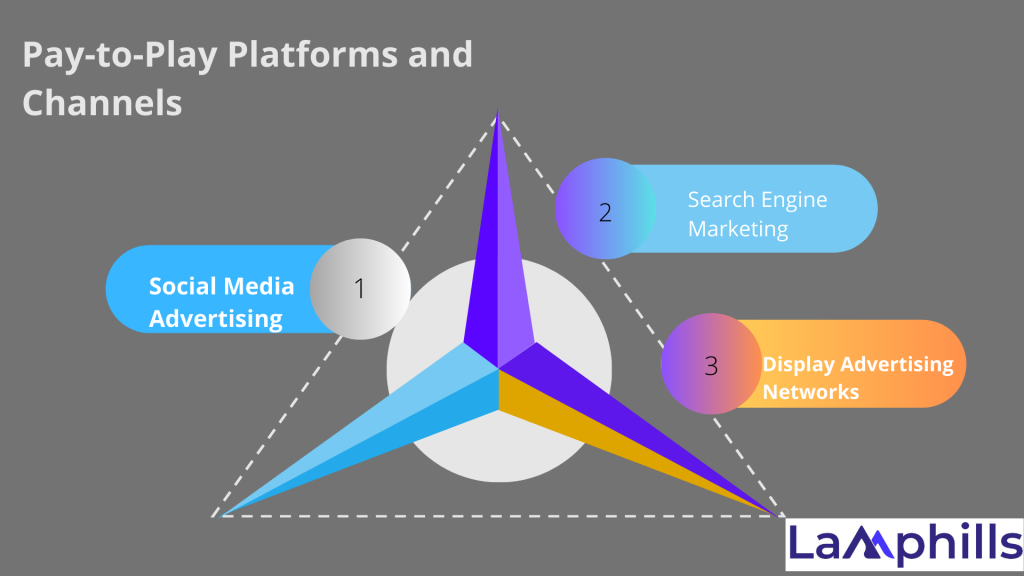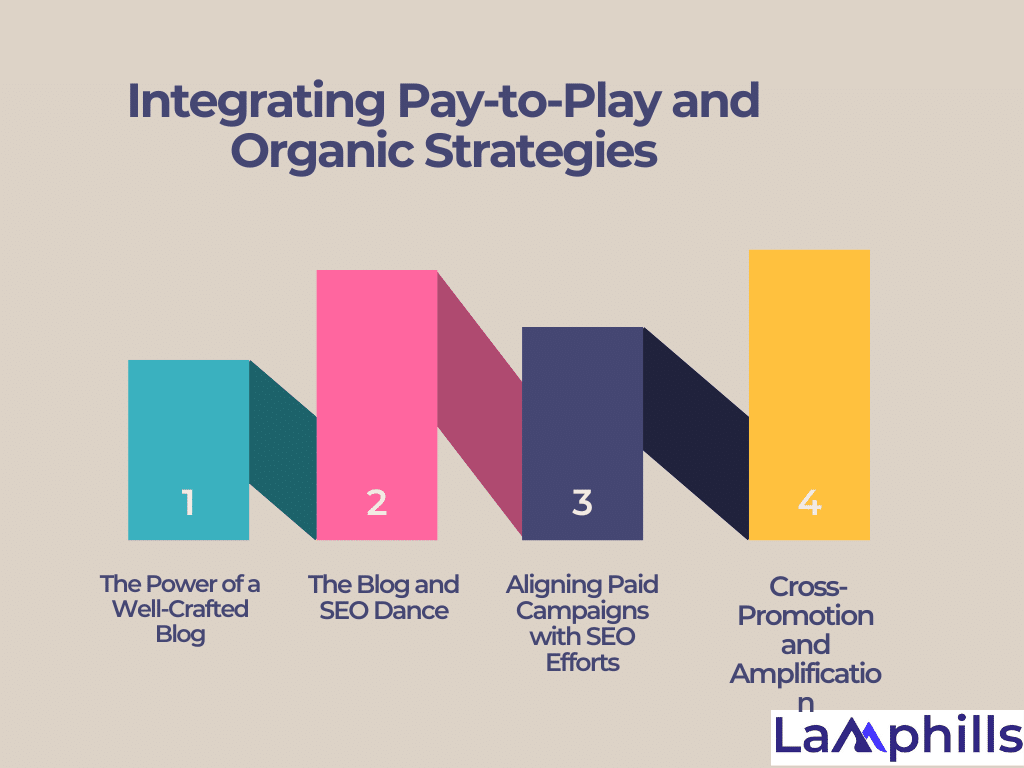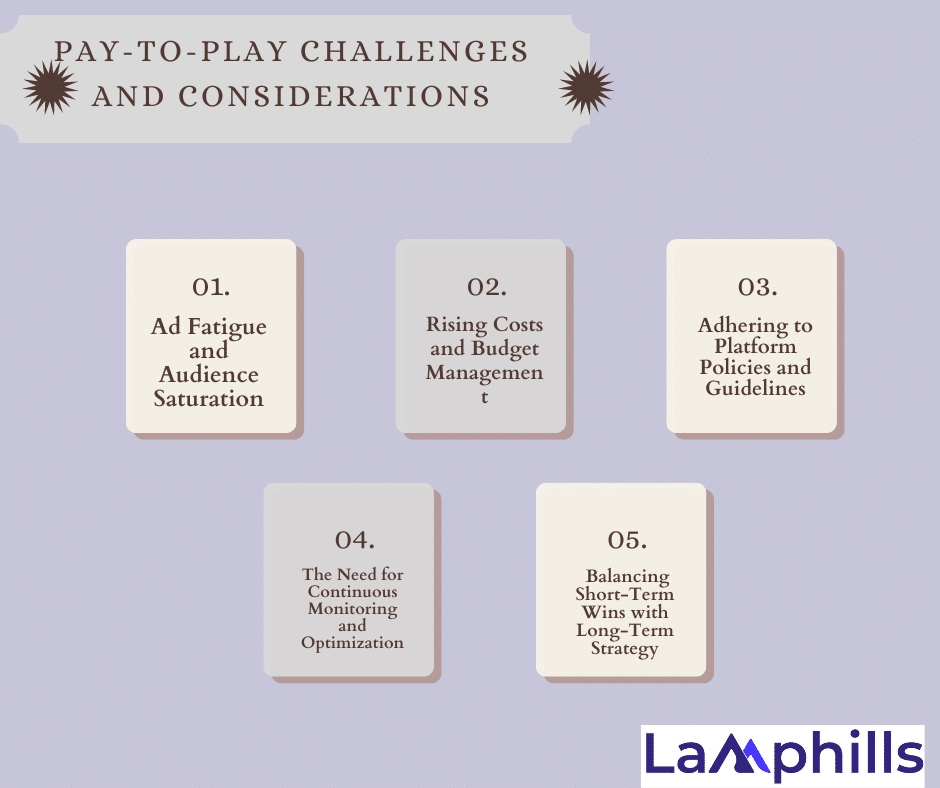It’s hard to believe now, but just a decade ago, the internet was flooded with pieces questioning how Facebook generates money. Today, no one is asking that anymore. Instead, we have come to recognize that advertising is the lifeblood of all major social networks. Paid social media has become an essential part of many firms’ marketing efforts. The more individuals use these platforms, the more money they earn from businesses that sell their products. It shows a company’s dedication to driving growth and paving the way for recognition, trustworthiness, and success in a variety of areas.
In today’s digital era, where information flows freely, and possibilities appear limitless, the allure of gaining something for nothing is strong. However, the notion that valuable exposure or promotion arrives without cost is often misguided in business. This is precisely where the concept of pay-to-play media marketing/advertising comes into play, establishing a mutual connection between investment and visibility. Read on to learn about pay-to-play.
Key Takeaways
- To stand out in today’s crowded digital landscape, businesses must now invest in paid strategies to ensure their content reaches the right audience.
- Pay-to-play models establish a symbiotic relationship between businesses and media platforms. Companies pay for the opportunity to showcase their products and services, gaining valuable exposure, while media platforms utilize these funds to sustain their operations and deliver quality content.
- One of the most compelling advantages of pay-to-play advertising is the ability to target specific audiences with precision and measure the effectiveness of campaigns. Platforms like Facebook and Google Ads offer detailed analytics and targeting options that allow businesses to reach their desired demographic efficiently and assess their return on investment (ROI) through metrics such as click-through rates (CTR) and conversion rates.
- Integrating pay-to-play strategies with organic efforts is crucial for a balanced and effective digital marketing approach. While paid campaigns can provide immediate visibility, organic strategies such as SEO and content marketing build long-term credibility and engagement.
What does pay-to-play mean?

Recently, one of my clients received an email from a senior producer of a new instructional television program hosted by a well-known long-time actor. The email mentioned an opportunity to be included in the show, which will air during primetime on three channels. Although this appears to be an excellent opportunity for a company to gain attention (with a Hollywood star, no less), it is crucial to remember that if anything sounds too good to be true, it most likely is.
For example, when I learned more about this performance, I discovered that if my clients wanted to participate, they would have to pay a large charge. In a sense, opportunities like this are pay-to-play schemes. This means participating in them can be more trouble than it’s worth for companies.
In this scenario, businesses spend money to get advertising space or promotional opportunities, allowing them to promote their products, services, or ideas to a larger audience.
In contrast, media platforms use these expenditures to sustain their operations and supply content to their audiences. This symbiotic relationship emphasizes the notion that, in today’s competitive business landscape, effective outreach and engagement frequently require a purposeful financial commitment. Did you know? Pay-to-play is not only a viable economic model but also a fair and successful method of gaining exposure and reputation.
Understanding Pay-to-Play
Companies typically hire public relations (PR) professionals to raise brand awareness. Public relations experts collaborate with journalists to secure earned media—”unpaid press coverage or publicity that a brand receives in a newspaper article, TV segment, product review, or some other medium”—for their clients. However, pay-to-play (also known as pay-for-performance) contradicts this. Pay-to-play refers to media coverage in which a brand pays the media to market its story.
Pay-for-performance appears to be comparable to advertising, in that brands buy spots on TV, social media, and print, but with one key difference: it is rarely declared as such. Instead, pay-to-play frequently misleads the audience and, in some cases, the firm into thinking it is legitimate press.
Pay-to-play schemes can be detrimental since they jeopardize a company’s reputation and consumer trust. If a firm pays for positive press without advocating something beneficial, its credibility is called into doubt. Earned media is important since it provides an objective assessment of a brand, whether positive or negative.
Pay-to-Play Platforms and Channels

Getting into the world of paid digital marketing might be like navigating a minefield. With so many platforms and channels to select from, deciding where to put your budget for the most impact can be difficult. I’ve done a lot of trial and error over the years to figure out what performs best across various platforms and businesses. Let’s take a look at some of the most productive platforms, interspersed with stories from my own experiences that may relate to you.
A. Social Media Advertising
Social media isn’t just about sharing cat videos or keeping up with friends—it’s a powerful tool for businesses to connect with their audience. With the right strategy, platforms like Facebook, Instagram, and LinkedIn can transform your marketing efforts.
#1. Facebook and Instagram
These two giants under the Meta umbrella are like the go-to tool for any marketer wanting to reach a broad audience.
- Vast Reach and Detailed Targeting: One of my favorite aspects of Facebook and Instagram ads is how specifically you can target your audience. You can zero in on demographics, interests, behaviors, and even past interactions with your business. This precision is golden.
- Engagement and Conversion: The visual nature of these platforms makes them perfect for creating engaging content that can turn casual viewers into enthusiastic customers.
#2. LinkedIn
I worked with a SaaS startup that wanted to interact with IT decision-makers. We launched a campaign aimed at CIOs and IT managers at mid-sized businesses. The CEO of the company called me, ecstatic that they had tripled their lead production in just a few months. LinkedIn’s exact targeting placed its software in front of those with the authority and desire to buy it. This has a significant impact on their business. LinkedIn is the preferred medium for B2B marketing. It’s a professional hangout, making it great for businesses looking to interact with other firms.
- Targeting Professionals: LinkedIn allows you to narrow your focus to specific job titles, industries, and even particular companies, which is incredibly powerful for reaching decision-makers.
- B2B Lead Generation: The professional setting and networking capabilities make LinkedIn perfect for generating high-quality B2B leads and establishing your brand as a thought leader.
B. Search Engine Marketing
When it comes to reaching people actively looking for your products or services, search engines are your best bet. Google Ads, in particular, is a powerhouse in this arena.
1. Google Ads
Google Ads lets you place your ads right where people are searching for what you offer, making it a key player in any marketing strategy.
- Capturing High-Intent Users: When people search on Google, they usually have a clear intent. They’re looking for answers, products, or services, which makes Google Ads incredibly effective for capturing this intent and turning it into action.
- PPC and Budget Control: With Google’s pay-per-click (PPC) model, you only pay when someone clicks on your ad. This makes it a cost-effective way to drive targeted traffic, and you have full control over your spending.
C. Display Advertising Networks
Display advertising encompasses banner ads, video ads, and other rich media that appear on various websites. It’s a great way to build brand awareness and reach a broad audience. These networks allow your ads to be seen across a vast array of websites, making them ideal for increasing your brand’s visibility and keeping it top-of-mind for potential customers.
- Brand Awareness and Visibility: Display ads are fantastic for spreading the word about your brand, even to people who aren’t actively looking for your products or services right now.
- Interactive and Engaging Formats: With options for static banners, animated graphics, and video ads, you can create engaging content that captures attention and drives action.
Furthermore, selecting the appropriate platforms and channels for your paid marketing efforts can have a big impact on your company’s success. Each offers distinct advantages and, when utilized strategically, may be extremely powerful. There is a platform to match your demands, whether you want the precision of Facebook and Instagram, the professional targeting of LinkedIn, the intent-driven aspect of Google Ads, or the broad visibility of display networks.
From my own experience, I’ve seen how a well-planned campaign on the correct platform can change the tide for businesses looking to expand locally or internationally. The idea is to explore, learn, and keep optimizing your strategies.
Integrating Pay-to-Play and Organic Strategies

Imagine your marketing strategy as a well-orchestrated symphony. Paid and organic tactics are the different instruments that, when played together, create harmony.
#1. The Power of a Well-Crafted Blog
Blogs are the invisible heroes of organic marketing. They provide valuable content that resonates with your audience and improves your search engine ranking over time. But here’s a little secret: coupling them with paid promotions can amplify their impact significantly.
#2. The Blog and SEO Dance
Consider a blog post to be a starting point for discussion. When you optimize your content for SEO, you ensure that search engines understand and value it, allowing it to appear at the top of search results. Assume you run a bakery and create a blog on the greatest bread-making processes. You’re more likely to attract individuals looking for “artisan bread recipes” and “home baking tips” if you include such keywords. And when you use paid advertisements to promote that piece, you reach a larger audience, perhaps converting casual readers into committed consumers.
This means, creating valuable content is just one part of the equation. To truly harness the power of your blog, you need to align it with your SEO strategy. In other words, focus on keywords that matter to your audience and structure your content in a way that search engines love.
#3. Aligning Paid Campaigns with SEO Efforts
Paid and organic strategies are not opposing forces; they’re complementary. Aligning your paid campaigns with your SEO efforts can create a seamless experience for your audience and reinforce your brand message.
a. Synergy Between Paid Ads and SEO
Paid search ads and organic search results should work hand in hand. When your ads and organic content share the same keywords and themes, it creates a cohesive brand presence across different channels.
b. Consistent Brand Messaging
Having your paid and organic strategies aligned ensures that your brand message is consistent across all touchpoints. This consistency builds trust and recognition among your audience.
#4. Cross-Promotion and Amplification
Cross-promotion is about making the most out of your existing resources. It’s like throwing a spotlight on your paid campaigns by using your organic channels to give them an extra boost.
a. The Role of Organic Social Media
Your organic social media presence is a powerful asset. It’s where your loyal followers engage with your content regularly. By sharing your paid promotions on these channels, you can extend
b. Creating a Buzz
Cross-promotion isn’t just about sharing links—it’s about creating excitement and anticipation across all your channels.
I must stress that combining paid and organic techniques is more than just doing more; it is about doing it better. It is about developing a marketing ecosystem in which each activity compliments the others, resulting in a stronger, more coherent brand presence.
From personal experience, I’ve seen how a balanced approach can turn minor victories into major accomplishments. Whether it’s a health and wellness site expanding its readership with a mix of SEO and paid advertisements, a local shop increasing sales with coordinated paid and organic search strategies, or a tech startup creating buzz with cross-promoted campaigns, the magic happens when these strategies are combined.
So, don’t think of paid and organic as two separate paths. Instead, see them as partners on the same journey, working together to lead your business toward greater visibility and success. Embrace the synergy, experiment with different approaches, and watch how this dynamic duo can elevate your marketing game to new heights.
Pay-to-Play Challenges and Considerations

Starting the ‘Pay to Play’ journey in digital marketing is similar to embarking on an adventure. While the potential benefits are enormous, the path is not without risks. As someone who has negotiated this terrain with a variety of clients, I’ve faced my fair share of obstacles. Here is a detailed look at the major roadblocks you may encounter and how to turn them into opportunities for progress.
#1. Ad Fatigue and Audience Saturation
Imagine watching your favorite television show and seeing the same commercial again and again. Isn’t this annoying? That is exactly how your target audience feels when they are constantly assaulted with the same ads. This tendency, referred to as ad fatigue, can drastically reduce the impact of your ads.
What is advertising fatigue? Ad fatigue occurs when your target audience grows so used to your advertisements that they stop paying attention or, worse, find them annoying. This can result in decreased engagement rates and wasted ad spending.
To counteract ad weariness, consistently update your creative assets. Try out alternative forms, such as films, carousel advertisements, and interactive components. Rotate your advertising messages to keep them new and compelling. By constantly evolving your ads, you keep your audience interested and more likely to take action.
#2. Rising Costs and Budget Management
As more firms join the digital advertising bandwagon, competition for ad space increases, as do expenses. It might be difficult to keep your campaigns profitable in the face of escalating costs.
With rising demand for limited ad space, platforms such as Google and Facebook frequently experience an increase in bidding rates. This can quickly increase your advertising expenditures, making it more difficult to generate a positive return on investment (ROI).
To handle escalating costs, begin with a tiny test budget to determine which strategies work best for your campaigns. Use data-driven insights to efficiently distribute cash across many channels. Consider cost-effective tactics such as targeting niche keywords or less competitive ad spaces. Regularly analyze and change your bidding methods to ensure you’re getting the most bang for your buck.
#3. Adhering to Platform Policies and Guidelines
Each advertising platform follows its own set of regulations and restrictions. Maintaining compliance is critical since breaching these standards can result in penalties or possibly the suspension of your ad account.
Navigating the complexities of platform policies can be like walking a tightrope. Each platform has its own set of regulations, including content limits and ad forms.
So, make it a practice to keep up with each platform’s advertising guidelines. Check for policy modifications regularly, and make any adjustments to your campaigns. Use the tools given by the platforms to pre-check your ads for compliance. Being proactive allows you to avoid costly interruptions and keep your campaigns operating smoothly.
#4. The Need for Continuous Monitoring and Optimization
In the fast-paced world of digital advertising, taking it easy is not an option. Continuous monitoring and optimization are required to ensure that your campaigns work at their best.
This is because campaigns frequently necessitate continual changes and adjustments based on performance indicators. Without regular monitoring, you may overlook opportunities to improve or problems that could jeopardize your success.
So, set up regular check-ins to assess the effectiveness of your ads. A/B testing can be used to test various creatives, headlines, and targeting options. Determine which elements produce the best outcomes and iterate accordingly. The idea is to make data-driven decisions that keep your campaigns engaging and effective.
#5. Balancing Short-Term Wins with Long-Term Strategy
The attraction of instant gratification from paid advertising can sometimes obscure the importance of a long-term strategy. It is difficult to strike a balance between fast wins and long-term growth.
While paid advertising might provide immediate traffic and conversions, depending only on them can be expensive and unsustainable in the long run. It is critical to combine them with long-term plans for creating long-term value.
To do this, employ paid advertising to increase quick results while investing in organic techniques like content marketing, SEO, and social media to lay the groundwork for long-term success. This balanced strategy ensures that, while achieving fast victories, you also nurture your brand’s long-term growth and sustainability.
Finally, keep in mind that it’s not only about overcoming obstacles; it’s about making them into stepping stones toward your business’s success. So, gear up, stay agile, and keep experimenting until you find the perfect balance that works for you.
Strategies for Effective ‘Pay to Play’ Campaigns
Entering the realm of ‘Pay to Play’ marketing can feel like entering a fast-paced market where every decision can make or break your success. The appropriate tactics not only boost your efforts but also ensure that your investments deliver the highest returns. Drawing on my own experiences and lessons learned while working with various customers, let’s look at critical methods for operating effective ‘Pay to Play’ campaigns.
#1. Set Clear Objectives and Goals

One of the first lessons I learned about digital marketing was the significance of having a clear path. Without clear objectives, your campaign is like a ship at sea with no destination in sight.
This is because defining specific goals provides your campaign with direction and purpose. Whether you want to increase brand awareness, generate leads, or sell directly, knowing your end objective influences every aspect of your strategy, from the sort of ad you develop to the demographic you target and the metrics you track.
Pro Tip: Make your objectives SMART (specific, measurable, achievable, relevant, and time-bound). Instead of simply saying “increase traffic,” try to “increase website traffic by 20% over the next two months through targeted Facebook ads.”
#2. Audience Targeting and Segmentation
Think about selling a fancy car to a group of students looking for inexpensive transportation. It is critical to understand who you are talking to and adjust your message accordingly. Here’s where audience targeting and segmentation come into play.
Effective targeting entails segmenting your audience based on demographics, interests, and behaviors, among other factors. The more accurately you define your target group, the more likely you are to engage with potential clients who are interested in your offering.
Pro Tip: Use tools such as Facebook Ads Manager or Google Ads to dig down into specific audience characteristics. Test several segments and adjust your targeting based on which groups have the highest interaction and conversion rates.
#3. Budget Allocation and Bidding Strategies
Take a look at this comprehensive checklist for effective Ad budget management
Managing your finances correctly is similar to being a competent gardener. You must understand where to sow your seeds (money) and how much water (investment) each requires to grow and prosper.
Allocating your spending properly across many channels and campaigns can help you maximize your ROI. It’s about finding the correct balance between investing in proven performers and trying out fresh chances.
Pro Tip: Create a test budget to gather data on what works best. Use performance information to direct additional funding to high-performing campaigns and alter bids to remain competitive without overspending.
#4. Optimize for Effectiveness
In the world of ‘Pay to Play’, optimization is a continual process rather than a one-time activity. To sustain their success, your campaigns must be constantly adjusted, much as a seasoned chef perfects their dish.
Optimization entails fine-tuning different aspects of your campaigns based on performance data. To increase results, you may need to modify your ad wording, experiment with different images, or refine your targeting criteria.
Pro Tip: Use A/B testing to compare multiple versions of your advertisements and determine which ones perform best. To guide your optimization efforts, track metrics such as click-through rates (CTR), conversion rates, and cost per acquisition (CPA).
#5. Integrate Paid and Organic Strategies
While ‘Pay to Play’ can bring rapid visibility, it’s also critical to develop a firm basis using organic techniques. Consider blending fast-growing annuals and durable perennials in your yard.
Integrating sponsored advertisements with organic efforts guarantees that you not only get rapid results but also develop long-term value. Organic techniques, like as SEO and content marketing, require time to develop but bring long-term rewards.
Pro Tip: Use bought advertising to quickly enhance your best organic content. Align your paid search advertisements with your SEO strategy to strengthen your brand’s messaging across numerous channels. This comprehensive approach contributes to the development of a strong and long-term marketing presence.
Lastly, remember, that each campaign is a learning journey. Embrace the process, stay flexible, and keep refining your approach. Whether you’re a small business or a large corporation, these strategies will help you harness the full potential of ‘Pay to Play’ and elevate your digital marketing game to new heights.
The Benefits of ‘Pay to Play’

So, why embrace the ‘Pay to Play’ model? The advantages are compelling:
#1. Recognizing the Value Exchange
Getting noticed in today’s content-rich world has become a daunting task. Businesses, particularly startups and small businesses, frequently require assistance in capturing the attention of their target audience amid the noise. Pay-to-play advertising provides a transparent value exchange: businesses invest in promotion in exchange for access to established publications’ platforms and audiences. This collaborative effort ensures that both sides gain from the arrangement.
#2. A Fair Method of Monetization
Publishing companies and media outlets do not escape the price of producing high-quality content and maintaining a credible platform. Design, marketing, printing, distribution, and overall operations costs all require financial commitment. Pay-to-play advertising is an effective way for these groups to cover their costs while also providing legitimate opportunities for corporations to reach a larger audience. It is a mutually beneficial arrangement in which value is traded for value.
#3. Investing in Growth
When a company chooses to use pay-to-play advertising, it shows a commitment to its growth and success. By dedicating resources to such activities, firms essentially acknowledge the value of publicity, reputation, and authority in their sectors. This investing mentality distinguishes serious and dedicated entrepreneurs from those who are unwilling to invest in their businesses.
#4: The Evolution of Advertising Practices
While the concept of pay-to-play advertising in the digital domain has gained traction in recent years, it is not new. Traditional advertising channels, such as print and television, have traditionally followed a similar principle: the more you invest, the higher the quality and reach of your material. This approach applies to all forms of digital advertising, including pay-per-click and sponsored posts. Paying for exposure has been a successful strategy across various platforms for decades.
#5. Branding and Investment
Creating a strong brand presence is an expensive activity that involves meticulous planning, strategic execution, and financial commitment. Businesses make large investments in branding strategies to guarantee that their name is recognized and associated with quality. In essence, they are paying to play in the branding arena, demonstrating that financial commitment is often required for success.
#6: The Universal Truth of Payment
In the grand scheme of things, it’s not uncommon to come into situations in which payment is required to access specific perks or experiences. From education to entertainment, healthcare to leisure activities, practically every aspect of life demands payment. In this context, the idea of paying for valuable exposure through pay-to-play advertising resonates with the general understanding that quality often comes at a cost.
What is an example of pay-to-play?
Pay-to-play occurs when investment firms or their employees make campaign contributions to politicians or candidates for office in the hope of receiving business from the municipalities that those political figures represent.
What is the opposite of pay-to-play?
Free-to-play (F2P or FtP) video games are games that give players access to a significant portion of their content without paying or do not require paying to continue playing.
How can you identify a Pay-To-Play scheme?
Identifying a pay-to-play program is critical to avoiding being duped into joining. This entails paying attention to specific items. My client received an email stating that the instructional program would air during a prime-time window, but no time slot was specified. Pay-to-play chances will be intentionally unclear to avoid disclosing what they entail.
Another clue to watch for is when an opportunity appears on many networks. In the email, my client was informed that the show would air on three networks. The reason for this is that the person running the opportunity is unsure which one it will finish up on. The “opportunity” given, which was implied to be an interview, is an advertisement and functions accordingly.
Finally, even though it was pay-to-play, the initial email made no mention of money. That is by design. The objective is to pique the recipient’s interest in what is being “sold.” And, because the opportunity is simply an advertisement, someone must pay for it—and that someone is whoever accepts to participate.
Conclusion
The ‘Pay to Play’ approach has radically altered the internet marketing landscape. It provides unparalleled capabilities for visibility, targeting, and quantifiable results. To establish a holistic and effective marketing approach, paid methods must be integrated with organic efforts. Whether you’re a small business or a major organization, using the correct ‘Pay to Play’ methods creates considerable growth and success in today’s competitive market. So, are you ready to jump into the realm of ‘Pay to Play’?
References
Related Articles
- Local Advertising: 10 Best Free and Paid Local Advertising Ideas For Small Business in 2024
- How I Mastered Brand Communications: Strategies for Clear and Effective Messaging
- What Is Technology PR? Tips for Choosing the Best Agency for Your Tech Brand
- Backlinks Removal: Protecting Your Site from Harmful Links






